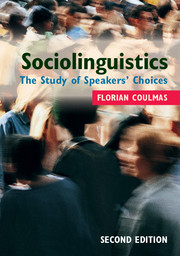Book contents
- Frontmatter
- Contents
- List of figures
- List of tables
- Preface to the second edition
- 1 Introduction: notions of language
- Part I Micro-choices
- Part II Macro-choices
- 7 Code-switching: linguistic choices across language boundaries
- 8 Diglossia and bilingualism: functional restrictions on language choice
- 9 Language spread, shift and maintenance: how groups choose their language
- 10 Language and identity: individual, social, national
- 11 Language planning: communication demands, public choice, utility
- 12 Select letters: a major divide
- 13 The language of choice
- 14 Research ethics
- Glossary of terms
- References
- Index
8 - Diglossia and bilingualism: functional restrictions on language choice
Published online by Cambridge University Press: 05 August 2013
- Frontmatter
- Contents
- List of figures
- List of tables
- Preface to the second edition
- 1 Introduction: notions of language
- Part I Micro-choices
- Part II Macro-choices
- 7 Code-switching: linguistic choices across language boundaries
- 8 Diglossia and bilingualism: functional restrictions on language choice
- 9 Language spread, shift and maintenance: how groups choose their language
- 10 Language and identity: individual, social, national
- 11 Language planning: communication demands, public choice, utility
- 12 Select letters: a major divide
- 13 The language of choice
- 14 Research ethics
- Glossary of terms
- References
- Index
Summary
– About my school, mum, dit l’enfant en marchant vers l’arrêt d’autobus
– Oui? Dit la maman.
– It’s a great school, isn’t it?
– Oui, c’est une école formidable, répond-elle avec sincérité.
– The best school in town?
– La meilleure de la ville, oui.
Pierrette Flatiaux, Allons-nous être heureux?Linguistic or cultural homogeneity of even one group is in a sense a fiction.
D. P. Pattanayak (1985: 402)Outline of the chapter
Given that some 6,800 languages are spoken in the world, which nowadays is divided into some 200 polities, there is bound to be a large number of situations where several languages coexist in close proximity: in one country, in one city, in one company, or in one family. These situations form the substance of this chapter. They are of interest to the sociolinguist because the coexistence of languages is patterned rather than random. To discover the social patterns of bilingualism is to understand an important dimension of speakers’ linguistic choices. To begin with, we consider a characteristic pattern of functional allocation of different languages or varieties that has attracted a great deal of attention. It is known as diglossia (from Greek δύο ‘two’ + γλώσσα ‘language’). The role of writing for the emergence of this pattern is discussed, comparing the Greek paradigm case with others in South Asia where it is particularly common. The remainder of the chapter treats other forms of societal bilingualism, considering the most important factors that have a bearing on the use of various languages, speech forms and styles. In language-contact situations, people develop a great variety of strategies to adjust their linguistic repertoires to the communicative purposes at hand, but whatever the situation, they invariably cooperate. This is most impressively in evidence when people of different linguistic backgrounds who do not share a common language interact for any length of time. In the event, they create a new one, a pidgin, that bridges the gap and, to the student of language in society, is testimony to the human desire to cooperate and to the ability to produce the means they need to do that. This process is touched upon, however briefly, at the end of the chapter.
- Type
- Chapter
- Information
- SociolinguisticsThe Study of Speakers' Choices, pp. 141 - 162Publisher: Cambridge University PressPrint publication year: 2013



